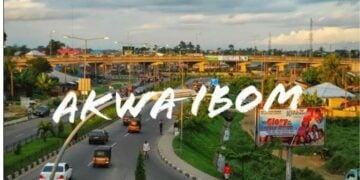The Nigerian Ports Authority (NPA) has intensified efforts to boost activities at the nation’s Eastern ports to decongest Lagos and strengthen Nigeria’s participation in the African Continental Free Trade Area (AfCFTA).
The authority’s managing director, Dr. Abubakar Dantsoho, has introduced a series of reforms covering tariffs, infrastructure rehabilitation, security, and strategic partnerships to reposition the ports of Onne, Port Harcourt, Warri, and Calabar.
For decades, Lagos ports have handled more than 90 per cent of Nigeria’s maritime traffic, leaving the Eastern ports underutilised due to shallow drafts, poor infrastructure, and security concerns. NPA said current interventions are beginning to change the narrative.
One of the milestones was recorded on July 31, 2025, when the Nigerian-owned MV Ocean Dragon, with a capacity of 349 TEUs, berthed at Onne’s West African Container Terminal (WACT). The vessel is expected to ply West, Central, and Southern Africa routes.
In March, NPA rolled out new tariffs to reflect operational realities while maintaining competitiveness. The move is tied to the Authority’s 25-year master plan, which prioritises automation, cybersecurity, and environmentally sustainable operations.
Shipping services at the Eastern ports have also expanded. Hapag-Lloyd recently launched a weekly service at Onne, linking the region to international trade routes. In addition, the Authority is working with the Nigeria Customs Service to implement 24-hour operations, intending to reduce clearance times and curb cargo diversion to neighbouring countries.
Official records show rising activity at the Eastern ports. Service boat Gross Registered Tonnage (GRT) increased by 129.3 per cent to 4.58 million tons in 2024. Stakeholders, including Indorama, have also reported increased export volumes. On the revenue side, NPA projects N1.28 trillion for 2025, compared with ₦894.86 billion generated in 2024.
Collaborations with relevant agencies of government, like the Nigeria Customs Service (NCS), for 24-hour operations aim to reduce cargo release times and curb diversions to neighbouring ports.
The NPA is developing a new incentive regime to encourage patronage of non-Lagos ports, including discounts and streamlined processes for Eastern corridors. Discussions with stakeholders like the Seaport Terminal Operators Association of Nigeria (STOAN) focus on boosting indigenous ownership and short-sea shipping.
These initiatives align with the federal government’s “Nigeria First” policy, emphasising infrastructure modernisation, operational efficiency, and indigenous participation in the maritime sector.
By enhancing capacity and security, the NPA aims to attract larger vessels, increase cargo throughput, and stimulate economic growth in Nigeria’s South-South and South-East regions.
Recent performance data shows promising results, with ship calls rising 5.6 per cent from 3,791 in 2023 to 4,005 in 2024, and Gross Registered Tonnage (GRT) surging 15.4 per cent to 142.66 million tons.63016d
The Authority has secured $1.1 billion for infrastructure rehabilitation projects covering Onne, Rivers, Warri, and Calabar ports. At Onne, a $2.9 billion expansion project is in progress, with 62 per cent of Terminal B (Berths 7 and 8) already completed through a partnership with West African Container Terminal Nigeria Limited. Dredging and rehabilitation work are ongoing at Calabar and Warri to improve vessel access.
To improve efficiency, NPA has deployed new harbour crafts, including two 80-tonne Bollard Pull tugboats, the first of their kind in Africa. The Authority has also expanded use of the electronic call-up system and Export Processing Terminals, which officials say have improved export flows.
Security patrols and navigational aids have been reinforced at Warri and Calabar pilotage districts, while tariff rebates and terminal concessions have been introduced to attract users.
NPA said the measures are expected to ease cargo movement for manufacturers in Aba, traders in Onitsha, and other industrial clusters in the South-East and North Central regions. These clusters have long depended on Lagos ports for imports and exports.
Industry observers note that dredging depth and infrastructure deficits remain major challenges despite these efforts. However, the Authority maintains that the ongoing interventions will position the Eastern ports as competitive gateways and reduce overdependence on Lagos.
Eastern ports are being repositioned as competitive gateways. The benefits for shippers are obvious: shorter turnaround times, closer access to the South-East and North Central industrial clusters, lower transportation costs, and the ability to move agricultural and mineral products more efficiently.
Despite its potential, weak infrastructure and limited connectivity that kept the Eastern ports underused, Lagos absorbed over 90 per cent of maritime traffic while Eastern facilities ran below a third of their capacity.
Breaking that cycle of shallow approaches through Escravos and Calabar has become a priority for NPA, and such reforms that include infrastructural and equipment upgrades, financial incentives, and stakeholder engagement have been put forward.
Channel dredging and rehabilitation are ongoing at Warri, Onne, and Calabar to accommodate larger vessels.
This is even though Onne has welcomed ships that once avoided the corridor.
“Security patrols across the Niger Delta are supported by partner agencies, thereby reducing piracy and other threats at sea while reassuring international shipping lines of the security of their vessels.
“On the commercial side, tariff rebates on harbour dues have lowered cost for users of the Eastern ports, while terminal concessions are driving private investment in modern cargo-handling equipment,”











